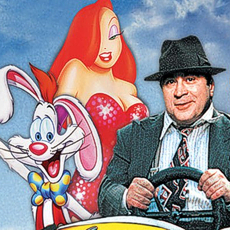Touchstone Pictures/Amblin Entertainment (June 22 1988), Buena Vista Home Entertainment (March 12 2013), Blu-ray plus DVD, 104 mins plus supplements, 1080p high-definition 1.85:1 widescreen, 5.1 DTS-HD Master Audio, Rated PG, Retail: $26.50
Storyboard:
1947 Hollywood: Who Framed Roger Rabbit follows famed animated “toon” star Roger as he gets deeper and deeper into trouble after cartoon gag-king Marvin Acme (yes, the boss of the same factory that supplies every one of Wile E Coyote’s Road Runner contraptions) is found murdered. The bunny goes on the run, turning to down-on-his-luck gumshoe Eddie Valiant, known for his celebrated assisting of toons in trouble. Eddie’s non-too pleased to see Roger since he became a toon-hating human after his brother was killed by a falling piano in a bank-job in down town ToonTown, the secret over-the-hill location set aside by Los Angeles for the cartoon characters of Hollywood to live without irritating their live-action counterparts. Turning up on the scene is Judge Doom, a mysteriously shady lawman with more connections than may first seem apparent, and a plan to reduce ToonTown to rubble so that he can carry out his dastardly freeway plans… Roger and Eddie must overcome their differences, outwit some nifty double crossers and join up to battle Doom and his sneaky team of Weasel cohorts to save ToonTown from the bulldozers!

The Sweatbox Review:
First appearing as a graphic novel comic-style book by Gary K Wolf, the now twenty-five-year-old Who Framed Roger Rabbit places the animated cartoon stars of yesteryear in the real-life world that we inhabit. Bought to the Disney Studio by then-Studio head Ron Miller, the film was put into development in the early 1980s, when the cost of producing the film to the standards thought to be needed proved too high. Eventual director Robert Zemeckis was actually offered the chance of helming the film in 1983, but the feeling in Hollywood at the time was that the once all-powerful Disney Studios were no longer in a position to mount such a huge production (Terry Gilliam also passed on the project, as he thought it would be “too difficult”!). The Disney Company takeover of 1984 put the film on hold for another couple of years until it resurfaced under the guidance of new Mouse chiefs Michael Eisner and Jeffrey Katzenberg, with none other than Steven Spielberg expressing an interest in coming on board as producer. Their choice to direct such a large-scale film was Zemeckis, who had just made a hit film for Spielberg’s Amblin Entertainment, Back To The Future. Three years later, they had another hit, when Roger opened to spectacular box-office returns in the summer of 1988.

Brilliantly directed by Zemeckis and complimented perfectly by Richard Williams’ truly groundbreaking traditional animation that redefined the technique and paved the way for the CG-enhanced “tradigital” films of the 1990s, Roger once again leaps from the screen to amaze and astound, and some of these sequences, even 25 years later, never fail to impress the viewer, with a dazzling display of innovative visuals and technical effects. This is one of those films when everything and everyone came together at the right time, to produce a pitch perfect movie that has become a true classic – its debut in a fresh HD transfer couldn’t have come at a better time. Originally considered for the role of Valiant was Gene Hackman, known for his hard-boiled detective roles, but eventual choice Bob Hoskins plays it better than anyone else ever could. His Eddie Valiant is dead-on, creating just the right tone of isolation and annoyance at Roger’s behavior, while never coming across as someone who does not have that little tiny part of them that remembers what being a kid and loving cartoons was like.
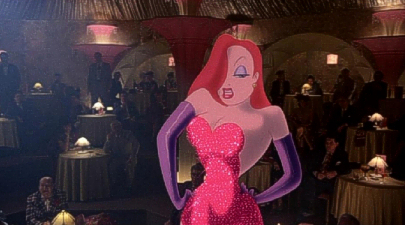
A triumph of animation and special effects, Roger himself integrates with the real world like no other cartoon character before (even if, thanks to computers, similar effects have been perfected since). Thanks to the involvement of Industrial Light And Magic, artists were able to add light and shadows to the toons, creating the real feeling of dimensionality. In promoting the film in 1988, Richard Williams joked that “it wasn’t three dimensionality, but 2-and-a-half at least!” However, the effect works so well for pretty much all of the movie that the illusion is soon forgotten and the film draws you in to the whodunit story itself. In fact the plot of Who Framed Roger Rabbit is far trickier than first appears, or other critics would have you believe, and is quite an accomplished labyrinthine thriller in itself – a “Chinatoon”, if you will, with a bunch of crazy characters thrown in to spin it on its head! The effects never outweigh the story, and it’s this attention to getting the plot right that really helps Roger to play as a “serious” movie for adults, while retaining the family angle. And at the end of the day, Roger lives up to its promise of being a tribute to all those toons we loved as kids, by being a film made by adults simply having fun and doing what makes them laugh!

There are a couple of inconsistencies in Roger Rabbit, although as a rabid fan I am duly forced to defend them, of course! One of the most widely remarked mistakes was made with The Singing Sword (itself a reference to the Bugs Bunny cartoon Knighty Knight Bugs), which sings in a Frank Sinatra voice. Nothing wrong with that I hear you say, but anyone wanting to criticise can point out that the song sung, Witchcraft, would not be a Sinatra hit for a few years after the film’s 1947 setting. I would have to reply that I reckon songwriters Cy Coleman and Carolyn Leigh themselves acquired a Singing Sword ten years later, liked the song, and re-wrote it for Frank, who made it a hit in 1960 – simple! Another qualm was with Valiant’s pal Angelo’s comment in their frequent hangout the Terminal Bar, when Judge Doom asks if any of them had seen a rabbit. Angelo jokes that he has indeed, and puts his arm around his invisible friend “Harvey”, a reference to a film that did not appear until 1950. However, did you know that by this time Harvey was already an amazingly successful Pulitzer Prize winning Broadway play? The show first appeared in 1944, with James Stewart himself (later to play in the film version, which coincidentally shares Roger’s 104-minute running time) appearing for a limited time in 1947. So, little to complain about there!

Of course with a film this big in scope and technical ambitiousness, there are bound to be many “mistakes” and minor irregularities. But then again, for a film this big and with the amount of technical effects to keep an eye on, there are remarkably very few actual gaffs, unlike for instance the high-tech films of today which regularly beat each other for the film with most blunders in. Who Framed Roger Rabbit was also made a time (just) before computer technology allowed for perfect matte shots, digital wire removal, CG-enhanced clean-up effects and the like, which makes its achievements all the more worthwhile and remarkable. It’s certainly an all-round entertaining film, and one that is able to back itself up with strong storytelling and technical talent; a hit movie that did lots to put animation back on the map in moviegoers eyes, and played no small part in launching the Disney renaissance of the 1990s. Extremely highly recommended!

Is This Thing Loaded?
With Who Framed Roger Rabbit being one of my all time favorite films (the combination of Disney/Zemeckis/Spielberg must place it fairly high on any list), I’ve been an avid collector of many previous editions of the movie, from VHS tapes through LaserDisc, the two-disc Vista Series DVD and now this Blu-ray edition. I’m also, naturally, well versed in the many in-jokes that Roger’s original prints contained, from Baby Herman’s apparent flipping the bird near the film’s opening (a gag that I’ve never believed was intentional and didn’t really look anything like that to begin with), to Betty Boop and Jessica Rabbit’s one-frame-each of nudity, and the sneaking in of then Studio-chief Eisner’s home phone number on a ToonTown wall.
Once revealed to the wider public, after making it to early CAV editions of the LaserDisc, the jokes were pulled and erased from subsequent issues: Boop’s boob frame was simply cut, and Jessica’s dress was modified so as to retain her modesty…and quite frankly even as a huge fan I’m perfectly good with these “fixes”. They don’t affect the entertainment quality and were never really intended to be seen: they didn’t officially exist to begin with, and now they officially don’t exist for real. No harm, no foul…let’s move on to where the one real disappointment lies in this new Blu-ray edition, supposedly celebrating the film’s 25th birthday by simply porting over the DVD’s 15th anniversary extras and providing nothing new for the occasion.

As a major fan, I was hoping this would provide the opportunity to include the vintage Joanna Cassidy-hosted 50-minute special Roger Rabbit And The Secrets Of ToonTown, a fantastic old-school behind-the-scenes documentary that aired on TV during Roger’s original 1988 theatrical release. This program also included several snippets of additional deleted scenes that are nowhere to be found on this new disc, and it would have been nice to have either had the Secrets program or a deleted scenes montage. Bringing over the previous DVD’s package of extras does include a lot of nice stuff, but Secrets could easily have been added as an extra enticement.
Dropping the CG-animated Benny The Cab menus from the Vista discs, this new BD edition menu suggests a pretty stacked affair for those coming to the title for the first time, while long-time fans will appreciate the assemblage of previous extras in one place even if there isn’t anything new. The menu is pretty great, featuring a ToonTown wall covered with crash, bang, wallop moments from the movie as a selection of animations zoom by…much more elaborate than needed or expected: one thinks this was perhaps a labor of love by someone who wanted to see this done right. Carried over is an excellent full-length commentary track featuring director Robert Zemeckis, producer Frank Marshall, writers Jeffrey Price and Peter Seaman, co-producer Steve Starkey and visual effects whiz Ken Ralston.
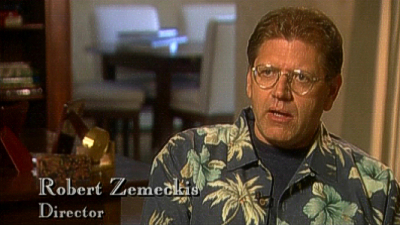
Each describe in some detail how challenging the film was to make, and the amazing logistics they had to overcome to bring it to the screen, in a track originally recorded for a 1998 Special Edition LaserDisc that also contained the three follow-up Maroon Cartoons. It remains a fun commentary, the crew recall the most tiny moments in the film’s production, explain Steven Spielberg’s contribution, and point out a few gaffs along the way too, although they make one gaff of their own that I have to clarify: someone mentions that the film was shot in England at “a studio that no longer exists, called Elstree Studios”. It’s true that Elstree had had a rough time surviving after Roger and producer Marshall’s next film, Indiana Jones And The Last Crusade, but the Studio is indeed still there in my old home town, serving as a base for George Lucas’ Star Wars prequels and such films as the recent The Kings Speech.
A major treat is the inclusion of the three Roger Rabbit Shorts (also known as the Maroon Cartoons) – now in HD! Produced as “mini-sequels” after the huge success of the feature in theaters to keep Roger in the public’s mind for the as-yet unmade sequel, Tummy Trouble was first out of the gate, released just one year later in 1989. Roger has to look after Baby Herman again but inevitably screws up when Herman swallows a baby rattle, so it’s off to St Nowhere’s hospital where Roger is soon up to his bow-tied neck in emergency room trouble. It’s a really funny cartoon, and the only one of the three that plays through to completion without resorting to rather choppy endings. A nice throwback to the original film comes at the finale, when the camera pulls back to reveal the live-action set and Jessica (also seen in the short as one of the most attractive nurses in film-history – “hello nurse!” indeed) waiting to take Roger home.

Tummy Trouble originally played with Honey, I Shrunk The Kids in theaters, and was seen as a major part of that film’s success, while Roller Coaster Rabbit, released with Dick Tracy in 1990 (and again with Toy Story in 1995) disappoints slightly with a strangely non-eventful ending alongside some frankly hysterical gags. On an outing to a fairground with Mother and Baby Herman, Roger is once again left holding the Baby, who again escapes from Roger’s not-so watchful eyes and is soon leading the bunny on chase through dangerous attractions, which of course leave Baby Herman unscathed and Roger a shivering mess! The two end up in a fantastically high roller coaster cart which spins and twists through an almighty maze of tracks and outrageously fast-paced gags, but the short comes to an abrupt end when the cart takes a wrong turn and smashes off the set and into the real world, where the director insists on Roger doing “the whole take again”!
On release with 1993’s A Far Off Place, Trail Mix-Up was virtually invisible in that film’s advertising and remains the least seen Roger/Maroon Cartoon. It’s also one of the best (though again suffers from an ending that cuts the action short), finding Roger, Baby and Mother in a wildlife park where Roger is inevitably given the task of watching over Herman while Mother goes off hunting. Distracted by sexy forest ranger Jessica, Roger loses Herman and the chase is once again on. Both Tummy Trouble and Roller Coaster Rabbit were directed by animator Rob Minkoff (later of The Lion King), while this last effort – here in a direct digital print – falls to Barry Cook to helm, doing a sterling job in carrying on with the Tex Avery-paced style and coming up with some of the best gags in the short-run series. Again things end when things on set go wrong, but this one has a good pay-off and it’s worth watching the credits for an amusing, post-title finish.

On release, one joke flew by too quickly in Trail Mix-Up for audiences to notice, but viewers of the now hard to find CAV LaserDisc compilation The Best Of Roger Rabbit did chance upon a background gag only seen in freeze-frame mode: when Roger swoops down to rescue Baby Herman from certain doom in the sawmill, he passes by a poster advertising Rigid Tools, featuring the definite shape of a woman straddling a chainsaw. The image was the reason the LaserDisc was pulled, with subsequent issues on DVD having the poster airbrushed out, making the image a blob of messy shapes rather than a noticeable picture. In this edition, eliminates any questions and totally blurs out the poster once and for all – unless you know where to look you wouldn’t even know it was there, or not as the case may be. It wouldn’t be the first or last time Roger would be censored: a fourth short, A Hare In My Soup was nixed by Spielberg over rights issues.
Next up is the first of the behind the scenes featurettes, presented (as are all the rest of the supplements) in standard definition 4:3 or 4:3 letterboxed. Who Made Roger Rabbit, hosted by Roger and Benny’s vocal artist Charles Fleischer, features much on-set material from the original 1988 release’s electronic press kit. Initially appearing on the “family-friendly” disc in the Vista set, this 11-minute piece takes us behind the scenes (including the crazy vocalist on set in his rabbit costume!) in a typically kid-appealing way, explaining the ins and outs of production as simply as possible and with a lot of video tricks to have Fleischer interact with the various pop-up screens. It’s a surprisingly entertaining program, even if it is meant for kids, and reminds us of the film’s production achievements.
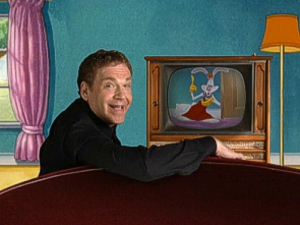
A Deleted Scene: The Pig Head Sequence (5:30 with introduction) remains by far my most favorite bonus. The first shots to be animated, this sequence was later dropped as the quality of the animation was quickly topped during production and Zemeckis felt that this scene, coming in the middle of the picture, would suddenly jump out at the viewer as not being high enough in standard (although here it is explained that they thought it “slowed the story down”). The scene is totally completed, with finished sound and color, and was in fact inserted back into the film for certain TV screenings. The sequence (coming just before Jessica visits Eddie in his office) explains why Eddie is coming out of the shower when she arrives, and it’s great to see it again, though I still wish it could have been included in HD as a branching option to run the scene within the movie rather than just from a pan-and-scan workprint.

Before And After (3:07) highlights the entire Eddie-in-ToonTown sequence in split-screen form, with the completed film playing against what was shot on set. Blue screens, prop rigs and storyboards all play a part in the creation of a classic scene and, although this is less a featurette and more simply an intriguing side-by-side styled look at the production process, it just goes to show how committed Hoskins was in his portrayal and ability to convey Valiant. Likewise, Toon Stand-Ins (3:14) is more on-set footage, although this time with some brief comments from the filmmakers, revealing shots from the Terminal Bar room brawl with the rubber stand-in characters in place for rehearsals, which were then removed and re-shot for the animation to be added in.
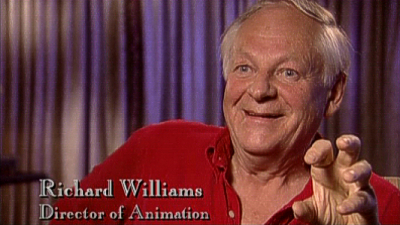
The centerpiece of the Vista set was the documentary retrospective Behind The Ears: The True Story Of Roger Rabbit (36:37), included again here. Using footage shot at the time of production, as well as clips from the movie and more recent “talking head” interviews with the principle filmmakers, it seems the main ambition of the program is mostly to explain just how “seat of their pants” the making of Who Framed Roger Rabbit really was. No one had made a movie like this before and so they had to make up the rules as they went along! Much of the material had been covered before (in the original Secrets Of ToonTown program and the commentary on this disc), but it is nice to get a perspective view – no pun intended – on the production from those closest to Roger. Best of all is the chance to see Richard Williams’ 30-second test that convinced all the major parties (mainly Disney and Spielberg) that a Roger Rabbit toon could “live” in the real world with great believability.
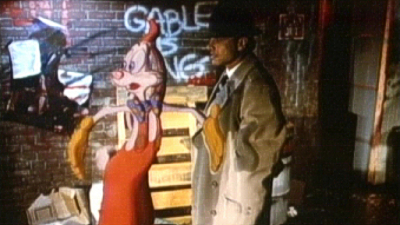
On Set! (4:50, previously known as On Set With Benny The Cab) features a final helping of production footage, this time shown “as it happens”, with Zemeckis and the crew setting up and filming some shots. There are no quick cuts, and the material is allowed to speak for itself, and although these three clips aren’t “making of” featurettes that zip by quickly, they do offer a very interesting insight into the filming process from a basic, and therefore plain-to-see, point of view of what – and how laborious – it must have been like to be working on the film for two and half years.
On the included DVD, a mishap saw the first disc of the original Vista Series disc bundled into this package instead of the advertised THX-approved widescreen edition of the film that was contained on the second disc in that set. Those with the “fullscreen” edition are encouraged to swap their platters for the proper version, which basically replicates the second disc from that Vista set and, Benny The Can menu aside, so loses DVD copies of the Who Made Roger Rabbit featurette, a Trouble In ToonTown set-top game, a trip to the Acme Factory for some jokes and hidden animations, the Original Theatrical Trailer Easter egg and the three Maroon Cartoons from the full-frame platter. However, this also means that everything else, from the commentary and deleted scene to the documentary and Valiant Files still galleries are all intact, offering a bunch of stuff to wade through – all kept in secret locations in Eddie’s office.
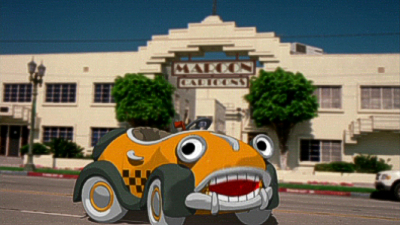
If you don’t fancy trying your investigative skills, click on the file paper for a list of “files” to pick out: there’s everything from Character Development, Concept Art (including alternate titles – Die Wundersamen Abenteuer Von Herbert Hase Im Trickfilm Land has to be a favorite – and some early Chuck Jones contributions), Stills and Publicity, with some really great alternate poster artwork and a look at the Disneyland recreation of ToonTown. An additional ToonTown Confidential trivia track plays as subtitled pop-ups during the actual movie, featuring an absolutely unstoppable amount of facts, figures and fun. Although only on the DVD, this is worth a once through and playing it with the commentary saves time and actually makes for a complimentary presentation, offering a wealth of interesting trivia, including the revealing of in-jokes and a couple of surprises, and making this a worthy DVD for those that never managed to grab the Vista set.

Of course, we could argue that there is much more that could have been included on this DVD, and even on the Blu-ray in this two-disc set itself: how cool might it have been to complete the interrupted Maroon Cartoon Something’s Cookin’ – the opening Roger short – for this release? Surely after Roger was cleared of murder, Raoul J Raoul finished off this mini-masterpiece before entering politics? Or even better would be to re-introduce the Rabbit in an exclusive new short, perhaps the never completed A Hare In My Soup? Well, at least Judge Doom didn’t manage to dip the set: with the three Maroon Cartoons in HD it’s hard to complain too much – everything such as it is turns up present and correct, and apart from the missing material mentioned above, fans of the Rabbit will be very happy that Roger’s Blu-ray debut hasn’t dropped as many extras as some of Disney’s other recent updates.
Case Study:
The lavish Vista packaging doesn’t make it to this BD edition, which is to be expected, but it still retains a deluxe feel. Interestingly, Roger hasn’t quite made it to clear Disney status in the way Jack Skellington has more recently been adopted from the Touchstone side of the Studio, although the sleeve also drops the Touchstone branding, leaving the credit mainly to producer Spielberg and director Zemeckis. The glossy slipcover replicates the sleeve underneath, and I’m not sure I like the tacked on 25th Anniversary label (which fails to match the film’s title treatment), but it’s otherwise a nice approach to what turns out to be a very light affair inside: all we get are the two discs in a standard BD case.
Ink And Paint:
Dropping the 1.33:1 fullscreen print from one of the Vista discs (except, of course, if you were unlucky enough to pick up a set that included that disc by mistake – oops!), Who Framed Roger Rabbit’s Blu-ray goes for the clear and correct 1.85:1 theatrical framing. With the added Maroon shorts and amount of supplemental material (even in standard definition), one might worry about the movie being given enough space to shine, but shine it does! Due to the way the film was matted together in an optical printer, it will never have the illumination and clarity of a film from today, even given the obvious digital makeover this print has been given, but it’s a good-looking, authentically film, transfer.

There’s a healthy but not troublesome amount of grain – perhaps akin to the lesser Disney animated classic treatment – and colors are strong (although I might have toned down the red gamma which blurs out Roger’s line animation sometimes), while compression is a no-show on both the movie, the shorts and the newly AVC-encoded extras that lose the noticeable macro blocking, mosquito noise and interlace shimmering that sometimes plagued supplements such as the Behind The Ears documentary. Surprisingly, Roger’s clarity also shows how good the matte work was: even going under the HD microscope only goes to exemplify how terrific this old-school analog achievement was.
Scratch Tracks:
An early beneficiary of digital sound recording, and always a film with an exceptionally aggressive sound mix, Roger Rabbit retains the DTS track – now uncompressed – that we heard in the Vista set. Spaciousness abounds, and there’s a terrific punch in the lower frequencies even if the overall sound is slightly more focused on the top end in dynamics than the bassy blockbusters of today. The dialog, much of it dubbed in later, is locked center stage, with the zany sound effects spilling from all corners. Speaking of an earlier Spielberg/Zemeckis collaboration, 1941, New York film critic Pauline Kael commented that the movie was like having your head stuck in a pin-ball machine for two hours. Zemeckis later used this quote to describe Roger, and listening to the sound mix on display here, you’ll understand exactly what he means! Well-dubbed French and Spanish tracks are also available on both versions of the film, with English subtitles also an option.
Final Cut:
As you’ll probably have noticed, Who Framed Roger Rabbit is one of my most favorite films and this Blu-ray update thankfully retains the essential supplements from the excellent Vista DVD and, while the lack of anything new is a disappointment, even with the Maroon Cartoon upgrades to HD status. The 25th anniversary badge is nothing more than a way to label this edition as something special, and although everything has been ported over from the Vista’s 15th anniversary it’s still a solid package that should wow newcomers to this material, which provides suitably comprehensive treatment for a truly groundbreaking movie, and will hopefully help Roger find many new fans. The legacy of the film is hard to calculate – Roger arguably sparked a new interest in animation, its techniques led to the amazing visuals of Disney’s renaissance, and its humor can still be felt in any number of CG or television animated comedies.
There have been attempts, particularly with the Looney Tunes features, but no-one has managed to outclass the combination of animation and live-action as well since, and the switch to CG integration just doesn’t have the same feeling of technical accomplishment as in having achieved what the crew managed here in a truly hand-crafted original. Although rivalry between Disney and Spielberg/Katzenberg’s studio DreamWorks still means that a Roger sequel would be a hard act to pull off, despite numerous efforts and even more recent partnerships between Zemeckis and Spielberg’s filmmaking outfits, perhaps that’s just as well. It may be that Who Framed Roger Rabbit should be a product of its time; this (almost) definitive Blu-ray being a fine representation of this amazing and downright magical movie, and an essential addition to any serious film collection, animated or otherwise!
 | ||
 |


